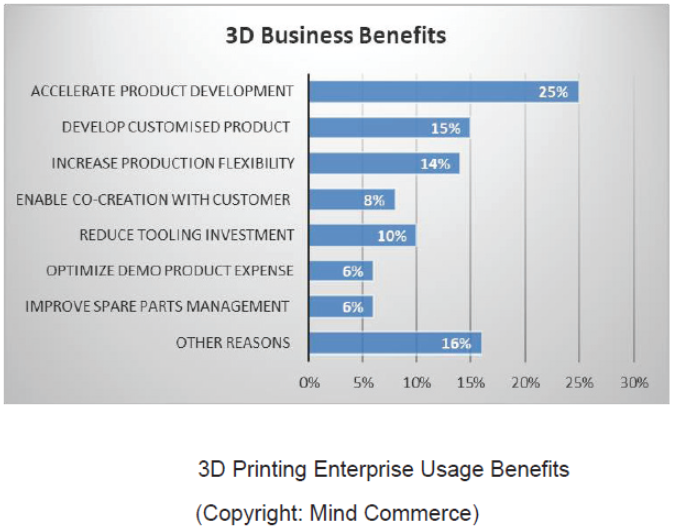6 Key Benefits of 3D Printing That Will Drive Wider Adoption Among Businesses
Despite major spikes of usage of 3D printing in industrial manufacturing and the enterprise arena, it has historically lagged behind traditional manufacturing processes in some aspects.

Despite major spikes of usage of 3D printing in industrial manufacturing and the enterprise arena, it has historically lagged behind traditional manufacturing processes in some aspects. This article discusses some of the crucial business benefits of 3D printing and how it will ultimately lead to much more wide adoption in the business sector within the next five to seven years. As a whole, 3D printing is all about adaptability, flexibility, and cost reduction. It’s all about the ability for businesses to offer fabrication on a more real-time basis and to reduce inventory of finished goods. From a balance sheet perspective, carrying the cost of materials is much more attractive than carrying the cost of finished goods in inventory. However, the benefits of 3D printing for business go well beyond accounting. 3D printing helps designers creating complex shapes and parts of product design that are usually impossible with traditional manufacturing methods. The additive methods of 3D printing allow printing of complicated designs with similar costs occurred in the conventional manufacturing process. Instead of focusing on standard size printing with the traditional manufacturing process, 3D printing allows easy customization on a design level to print. It doesn't require adding an expensive manufacturing process except changing the design digitally. Each and every item can be customized as per user demand without additional manufacturing costs. Unlike the traditional manufacturing process that requires creating new mold wasting metal for every part of the product, 3D printing simply uses a single tool process where there is no need to change the aspect of product with every design. This process does not add additional costs or require additional time to produce a final product that eventually helps keep the fixed costs lower to a substantial amount. Since changing the design digitally is the only requirement to create a new prototype with the additive 3D printing process, it helps entrepreneurs or businesses to test and launch the product much faster than the traditional manufacturing process. It is also considered to be the less risky route to bring any new idea to market. In most cases, in the process of traditional manufacturing more than 90% of the raw material gets wasted since it goes through a blocking material, cutting it, machining it, and milling it until the final product is printed. Whereas the 3D printing process follows adding materials layer by layer to create objects from the raw material that helps cut raw material waste in the process. Ideally, most of these raw materials can also be recycled and repurposed to create more 3D printed objects. Apart from above mentioned benefits, the usage of 3D printing brings some direct benefits for enterprises. Some of them includes accelerating product development process within enterprise, creating a high degree of flexibility in the production system, enabling co-creation of product development with customers, reducing substantial investment in tooling and expenses in preparing demo products, and improving management of spare parts. It is estimated that 57% of all types of 3D printing usage is inspired by new product development but it also brings other mentioned benefits too. The following chart shows the graphical representation of core business benefits for enterprises for using 3D printing within organizations. In addition, the report covers leading additive manufacturing companies, features multidimensional additive manufacturing market analysis, and discusses technology along with potential use cases. Mind Commerce is a trusted source for research and strategic analysis focused on digital technologies and the telecommunications industry. Mind Commerce reports are designed to provide decision makers with technological insights to improve business intelligence. Mind Commerce reports provide key trends, projections, and in-depth analysis for infrastructure, platforms, devices, applications, services, emerging business models and opportunities. 1. Creation of Complex Design
2. High Level of Customization
3. Lower Fixed Costs and Adaptive Operational Expenses
4. Prototyping Cycle Time Reduction
5. Industry Waste Reduction
6. Many Enterprise Usage Benefits

Where to Learn More
 This article is an excerpt from the report Additive Manufacturing Market Outlook and Forecasts 2022-2030 by the market research firm Mind Commerce. This comprehensive, 211-page report provides detailed information on additive manufacturing market size and market growth.
This article is an excerpt from the report Additive Manufacturing Market Outlook and Forecasts 2022-2030 by the market research firm Mind Commerce. This comprehensive, 211-page report provides detailed information on additive manufacturing market size and market growth.About Mind Commerce

 AbJimroe
AbJimroe 







![3 Tips for Hiring Team Members for Your Marketing Agency with Jeff Hunter [VIDEO]](https://www.digitalmarketer.com/wp-content/uploads/2022/05/SAVAGE_MARKETING_THREE_TIPS_THUMBNAIL.jpg)
























